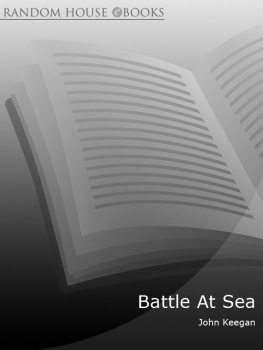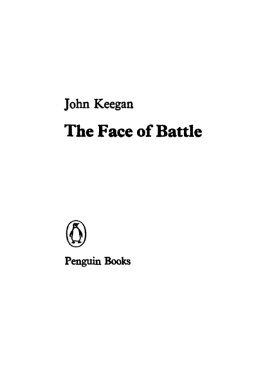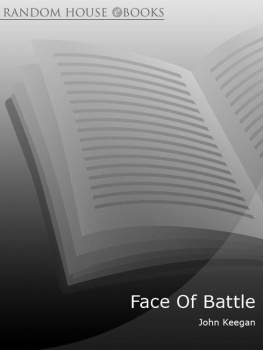THE MASK OF COMMAND
A Study of Generalship
JOHN KEEGAN
www.vintage-books.co.uk
This ebook is copyright material and must not be copied, reproduced, transferred, distributed, leased, licensed or publicly performed or used in any way except as specifically permitted in writing by the publishers, as allowed under the terms and conditions under which it was purchased or as strictly permitted by applicable copyright law. Any unauthorised distribution or use of this text may be a direct infringement of the authors and publishers rights and those responsible may be liable in law accordingly.
Version 1.0
Epub ISBN 9781446498149
www.randomhouse.co.uk
Published by Pimlico 2004
6 8 10 9 7
Copyright John Keegan 1987
This book is sold subject to the condition that it shall not, by way of trade or otherwise, be lent, resold, hired out, or otherwise circulated without the publishers prior consent in any form of binding or cover other than that in which it is published and without a similar condition including this condition being imposed on the subsequent purchaser
First published in Great Britain by
Jonathan Cape Ltd 1987
First Pimlico edition 1999
Second Pimlico edition 2004
Pimlico
Random House, 20 Vauxhall Bridge Road,
London SW1V 2SA
Random House Australia (Pty) Limited
20 Alfred Street, Milsons Point, Sydney,
New South Wales 2061, Australia
Random House New Zealand Limited
18 Poland Road, Glenfield,
Auckland 10, New Zealand
Random House South Africa (Pty) Limited
Endulini, 5A Jubilee Road, Parktown 2193, South Africa
Random House UK Limited Reg. No. 954009
A CIP catalogue record for this book is available from the British Library
ISBN 9781844137381
Contents
To Susanne
About the Author
John Keegan is the Defence Editor of the Daily Telegraph and Britains foremost military historian. The Reith Lecturer in 1998, he is the author of many bestselling books including The Face of Battle, Six Armies in Normandy, Battle at Sea, The Second World War, A History of Warfare (awarded the Duff Cooper Prize), Warpaths, The Battle for History, The First World War, and most recently, Intelligence in War.
For many years John Keegan was the Senior Lecturer in Military History at the Royal Military Academy Sandhurst, and he has been a Fellow of Princeton University and Delmas Distinguished Professor of History at Vassar. He is Fellow of the Royal Society of Literature. He received the OBE in the Gulf War honours list, and was knighted in the Millennium honours list in 1999.
Illustrations
PLATES
Alexander the Great
Alexander and Bucephalus
Alexander at Issus
Alexander at the Granicus
Alexander and Olympias
Philip II of Macedon
Alexander in Battle
Wellington
The Battle of Assaye
Wellington at Assaye
Wellington at Salamanca
The Battle of Salamanca
Wellingtons Waterloo Orders
Hougoumont and La Haye Sainte
Grant
The Capture of Fort Donelson
The Battle of Shiloh
Grants Vicksburg Canal
The Siege of Vicksburg
Grant and Pemberton
Lincoln, McClernand and Pemberton
Grant and Rawlins
Hitler
Hitler Rehearsing
Hitler and Baldur von Schirach
Hitler Picnicking
Hitler, Jodl and Keitel
Hitler in Berlin, April 1945
MAPS
The Course and Extent of Alexanders Conquests, 334323 B.C.
Wellingtons Campaigns in India, 17991803
Wellingtons Campaigns in the Peninsula, 180814
Wellington at Waterloo, June 18, 1815
The Theatre of Operations of the American Civil War, 18615
Grant at Shiloh, April 67, 1862
Hitlers Empire and the Location of his Headquarters, 193945
Acknowledgement is made to the following publishers, picture libraries and archives for the use of plates: Weidenfeld & Nicolson (1, 5, 6, 7); Radio Times Hulton Picture Library (2, 3, 4, 9, 10, 11, 16, 17); Robert Hunt Library (15, 18, 19, 20, 21, 22, 24, 28); Barnabys Studio Ltd (23, 25, 26); Weimar Archive (27); Victoria and Albert Museum (8, 12, 13, 14).
Acknowledgements
This book was begun at the Royal Military Academy Sandhurst, continued while I was a Fellow of the Davis Centre at Princeton in 1984 and completed after I became Defence Correspondent of the Daily Telegraph in 1986. To my colleagues at all three I am grateful for much help and encouragement. I am particularly grateful to Dr Christopher Duffy, Dr Richard Holmes, Dr John Pimlott, Dr Patrick Griffith, Dr Anthony Clayton, Dr John Sweetman and Mr Keith Simpson at Sandhurst; to Professors Lawrence Stone, Theodore Rabb, Richard Challenor and Sean Wilentz at Princeton; and to Mr Max Hastings, Mr Andrew Hutchinson, Lord Deedes, Mr Nigel Wade, Mr James Allen, Mr Daniel Johnson and Miss Claire Jordan at the Daily Telegraph.
I owe special thanks to the staffs of several libraries: Mr John Hunt and his staff at the Central Library, Royal Military Academy Sandhurst, Mr Michael Sims and his staff at the Staff College Library, Mr John Andrews and Miss Mavis Simpson at the Ministry of Defence Library and the staffs of the Firestone Library, Princeton University and of the London Library.
Many soldiers, of senior and junior rank, have helped me to understand something of the nature of command, during twenty-five years largely spent in their company. I would particularly like to record thanks for conversations with Field-Marshal Lord Bramall, Lieutenant-General Sir George Gordon-Lennox, Lieutenant-General Sir John Chapple, Brigadier Peter Young, Colonel Michael Hardy, Colonel Giles Allen, Lieutenant-Colonel Alan Shepperd and Captain Desmond Lynch of the British army, Major-General David Butler of the Australian army, Colonel Berthold Schenk Graf von Stauffenberg of the German army, Lieutenant-Colonel Michel Camus of the French army and Generals Alfred C. Wedemeyer, Mark Clark and William Westmoreland of the United States army.
The manuscript was deciphered and typed by Miss Monica Alexander, to whom as always I am deeply grateful. It would not have reached her hands but for the support, advice and encouragement of my literary agent and great friend, Anthony Sheil, and of his transatlantic partner, Lois Wallace, also a friend of now almost as many years. I am deeply grateful to my publishers, Liz Calder, Tony Colwell, Alan Williams and, in particular, Elisabeth Sifton, who largely edited the manuscript. I am most grateful to Alison Mansbridge for her skilful copy editing. I owe a particular debt to my friend Paul Murphy for his support and understanding.
My love and thanks finally to my children, Lucy, and her husband Brooks Newmark, Thomas, Rose and Matthew, and to my darling wife, Susanne, to whom I offer this book as a housewarming.
Kilmington Manor | JOHN KEEGAN |
May 7, 1987 |
INTRODUCTION
Pre-Heroic Leadership
This book is about generals, who they are, what they do, and how what they do affects the world in which men and women live. It might be expected to proceed by one or other method favoured by those who have approached the subject before: the traits method or the behaviour method. The first takes as its premise the assumption that those who exercise military authority will reveal under examination a certain set of common characteristics. The second attempts to identify patterns of behaviour which distinguish leader from follower. Trait studies deal in the qualities of energy, decisiveness and self-confidence. Behaviour studies explore roles; roles of encouragement, dissuasion and coercion.
















